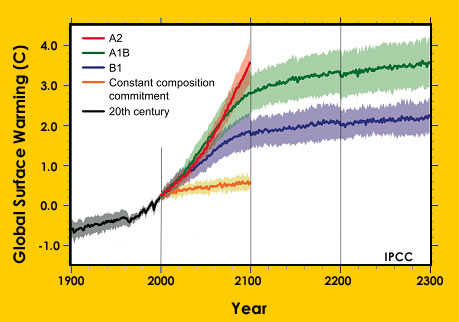Haz "click" en la imagen para una vista completa
Fuente: Modificado por el Museo de Ciencia Mariano Koshland de“Calentamiento del Planeta: Hechos y Nuestro futuro” 2004 de la Academia Nacional de Ciencias
Climate Literacy Framework
Essential Principles and Fundamental Concepts of Climate Science
Earth’s climate offers just the right conditions for life to thrive. Climate is the average weather over a long period of time — at least thirty years. For any given region, climate is described using long term trends in atmospheric temperature, humidity, pressure, wind, and rainfall. Climate is also affected by proximity to large bodies of water, ocean currents, and ice or snow cover, as well as altitude, latitude, and topography. Climate is regulated largely by concentrations of chemicals in the atmosphere called greenhouse gases which influence the amount of energy that is retained and lost to space by Earth’s atmosphere. Decreasing greenhouse gases cause global cooling, and increasing concentrations cause global warming. Observations of weather using instruments are reliable only to the early 19th century. Climate of the more distant past is revealed by paleontologists, scientists who interpret climate records found in fossils, tree rings, ocean and lake sediments, and ice cores. Climate scientists also are developing mathematical models of the Earth system which can simulate how climate changes over time under the influence of different levels of green house gas emissions.
Hundreds of scientists participating in the Intergovernmental Panel on Climate Change (IPCC) have concluded that the global warming observed since the middle of the 20th century is primarily the result of burning of fossil fuels which produces carbon dioxide, and land uses which cause deforestation. Impacts of global warming include rising sea level; less predictable precipitation patterns, higher frequency of severe weather; melting ice caps, glaciers, and permafrost; species extinctions; and changes in crop yields. In order to slow global warming and to inevitable changes, we must become better informed about climate and global change. A climate-literate public knows how to assess scientifically credible information about climate. It can communicate about and make well-informed decisions with regard to individual actions and public policies that may affect climate.
This climate science literacy guide identifies the essential principles and fundamental concepts that individuals and communities should understand about Earth’s climate system. Climate science literacy provides important insights into how the entire Earth system functions. For more information on this effort, please visit the Climate Science Literacy Framework web site. AAAS Project 2061 has created a guide called Communicating and Learning About Global Climate Change: An Abbreviated Guide for Teaching Climate Change that maps out what students should be learning in kindergarten through 12th grade and describes what a science literate adult should know and be able to do.
Guiding Principle for Informed Climate Decision:
Humans can take actions to reduce climate change and its impacts.
- Essential Principle 1: Life on Earth has been shaped by, depends on, and affects climate.
- Essential Principle 2: We increase our understanding of the climate system through observation and modeling.
- Essential Principle 3: The Sun is the primary source of energy for the climate system.
- Essential Principle 4: Earth's weather and climate systems are the result of complex interactions.
- Essential Principle 5: Earth's weather and climate vary over time and space.
- Essential Principle 6: Evidence indicates human activities are impacting the climate system.
- Essential Principle 7: Earth's climate system is influenced by complex human decisions involving economic costs and social values.















